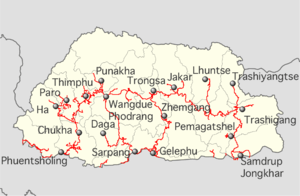List of protected areas of Bhutan
The protected areas of Bhutan are its national parks, nature preserves, and wildlife sanctuaries. Most of these protected areas were first set aside in the 1960s, originally covering most of the northern and southern regions of Bhutan. Today, protected areas cover more than 42% of the kingdom, mostly in the northern regions. Protected areas also line most of Bhutan's international borders with China and India.
Background

The government agency responsible for their oversight is the Ministry of Agriculture, Forestry Services Division.[2] Since 1992, protected areas have been managed by the Bhutan Trust Fund for Environmental Conservation. In 1993, the Fund revised and reduced its extensive parks system for better ecological representation and management. Through 2008, however, protected areas expanded significantly with the establishment of Wangchuck Centennial National Park, spanning a 4,914 square kilometres (1,897 sq mi) swath in northern Bhutan. The parks and sanctuaries are all connected either directly or by "biological corridors." As of 2011, the Fund had recruited 189 field staff, had trained 24 post-graduate specialists, and had provided over 300 short scientific courses. The Fund alone manages a total protected area of 16,396.43 square kilometres (6,330.70 sq mi) – nearly the size of Switzerland and more than 42 percent of Bhutan's total 38,394 square kilometres (14,824 sq mi). With the exception of Phibsoo Wildlife Sanctuary and Jigme Khesar Strict Nature Reserve, these protected areas are inhabited or are located within populated areas.[1][3]
In practice, the overlap of these extensive protected lands with populated areas has led to mutual habitat encroachment. The Lateral Road, Bhutan's main highway, bisects Phrumsengla National Park in the center of the kingdom. Protected wildlife has entered agricultural areas, trampling crops and killing livestock. In response, Bhutan has implemented an insurance scheme, begun constructing solar powered alarm fences, watch towers, and search lights, and has provided fodder and salt licks outside human settlement areas to encourage animals to stay away.[4]
List of protected areas
Below is a list of the ten protected areas of Bhutan maintained by the Trust Fund:[1]
- Bumdeling Wildlife Sanctuary (Lhuntse, Mongar, and Trashiyangtse Districts; contains the former Kulong Chu Wildlife Sanctuary)
- Jigme Dorji National Park (Gasa, Paro, Punakha, Thimphu, and Wangdue Phodrang Districts)
- Jigme Singye Wangchuck National Park (Sarpang, Tsirang, Trongsa, Wangdue Phodrang, and Zhemgang Districts)
- Jomotsangkha Wildlife Sanctuary (Samdrup Jongkhar District)
- Phibsoo Wildlife Sanctuary (Dagana and Sarpang Districts)
- Royal Manas National Park (Pemagatshel, Sarpang, and Zhemgang Districts)
- Sakteng Wildlife Sanctuary (Trashigang and Samdrup Jongkhar Districts)
- Phrumsengla National Park (Bumthang, Lhuntse, Mongar, and Zhemgang Districts)
- Jigme Khesar Strict Nature Reserve (Haa District)
- Wangchuck Centennial National Park (Bumthang, Gasa, Lhuntse, Trongsa, and Wangdue Phodrang Districts)
In addition, the Royal Government maintains the following protected areas:
The following areas of Bhutan are protected or maintained by private organizations:
See also
- Environmental issues in Bhutan
- Royal Society for the Protection of Nature (RSPN)
- List of Hot Springs and Mineral Springs of Bhutan
References
- 1 2 3 "Parks of Bhutan". Bhutan Trust Fund for Environmental Conservation online. Bhutan Trust Fund. Archived from the original on 2011-07-02. Retrieved 2011-03-26.
- ↑ "Parks" (PDF). Protected Areas Programme. 9 (3). IUCN – The World Conservation Union. October 1999: 43. Retrieved 2011-03-26.
- ↑ "The Organisation". Bhutan Trust Fund for Environmental Conservation online. Bhutan Trust Fund. Archived from the original on 2010-03-29. Retrieved 2011-03-26.
- ↑ Wangchuk, Jigme (2011-07-08). "Addressing Human-Wildlife Conflict". Bhutan Observer online. Archived from the original on 2011-09-01. Retrieved 2011-07-13.
- ↑ John D and Catherine T MacArthur Foundation (2010). "The Royal Society for Protection of Nature – Protecting Bhutan's rich biodiversity". 2010 MacArthur Award for Creative & Effective Institutions. Retrieved 2011-08-30.
- ↑ "Royal Society for the Protection of Nature". Bhutan Foundation. Retrieved 2011-08-31.
External links
- "ProtectedPlanet.net". Retrieved 2011-03-26.

